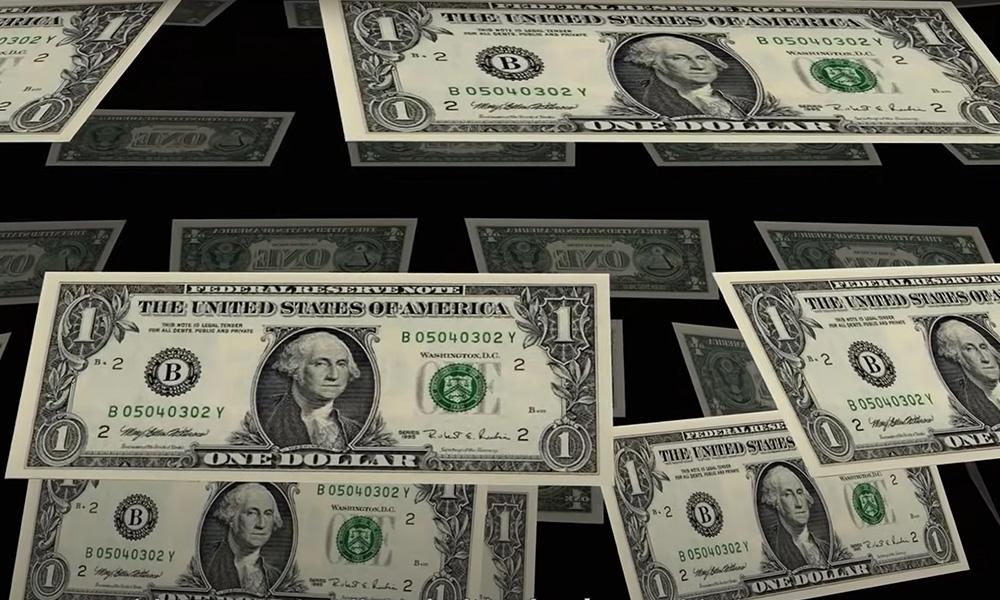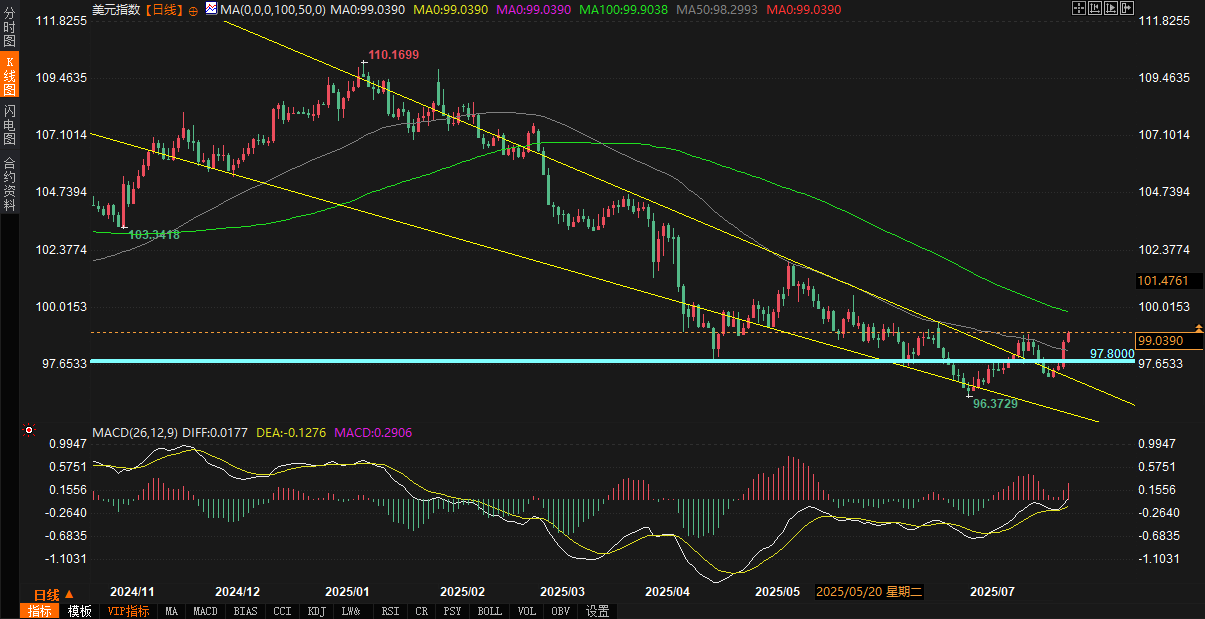The battle for the non-farm payroll report has begun! The US dollar index "gaps up" through the 98.89 high, and the short-seller retreat route is under double pressure from MACD/RSI.
2025-07-29 20:57:18

Fundamental analysis: Trade optimism and economic data drive the market
The US dollar index's rebound, which began in early July after hitting a three-year low of 96.38, has been gradually supported by multiple positive factors. First, market risk aversion triggered by Trump's tariff rhetoric has eased. The framework for the US-EU trade agreement announced on Sunday was particularly crucial, mitigating market concerns about the risk of high tariffs and securing significant economic benefits for the US. According to industry sources, the agreement stipulates a 15% base tariff on most EU imports, lower than the previously discussed 30% but higher than the original 10%. At the same time, strategic goods such as aviation parts, semiconductors, pharmaceuticals, and agricultural products are exempted from tariffs, ensuring supply chain stability. The EU, in turn, pledged to purchase $750 billion worth of US energy (primarily liquefied natural gas) over the next three years and to invest an additional $600 billion in the US through private sector investment. The market interpreted the agreement as strengthening the strategic advantages of the US economy and the US dollar.
Furthermore, trade agreements between the United States and other economies, such as Japan, further boosted market confidence. For example, the US-Japan agreement reduced auto tariffs from 27.5% to 15% and introduced a $550 billion investment plan covering key sectors such as semiconductors and energy. These agreements eased market concerns about the August 1 tariff deadline and reduced the pressure on the US dollar from global trade tensions. Meanwhile, strong US economic data further weakened market expectations for a rate cut at the Federal Reserve's July 29-30 meeting. According to the CME FedWatch tool, the market sees an almost zero chance of a rate cut this week, while the probability of a 25 basis point cut in September is approximately 60%. This reflects investors' confidence in the resilience of the US economy, particularly amid persistent inflationary pressures.
Tuesday's release of US economic data is drawing much attention, including the house price index, consumer confidence, and the JOLTS job vacancies report. The market expects the consumer confidence index to rise to 96.0 in June, a two-month high, from 93.0 in June, while the JOLTS job vacancies report is expected to fall to 7.55 million from 7.76 million in May. These data will provide the market with the latest clues about the US economy and labor market, with the JOLTS data being particularly important as a forward indicator of Friday's non-farm payroll report. If the data meets or exceeds expectations, it could further consolidate the dollar's strength. However, if job vacancies unexpectedly fall sharply below 7 million, it could spark concerns about a cooling labor market, increasing expectations of a September interest rate cut and exerting short-term pressure on the dollar.
Notably, the US Treasury recently announced plans for $1.6 trillion in net new market debt through the second half of 2025 ($1.007 trillion in the third quarter and $590 billion in the fourth quarter), of which approximately $500 billion is used to rebuild the Treasury General Account (TGA). This massive issuance has put pressure on the bond market, with 30-year Treasury yields approaching 4.96%, 10-year yields reaching 4.41%, and 2-year yields nearing 4%. High financing costs could pose challenges to the US fiscal outlook, and the market is beginning to worry about the potential crowding-out effect on private investment. Despite this, the dollar's appeal as a safe-haven asset remains strong in the current environment.
The foreign exchange options market offers some forward-looking clues. According to analysts at leading institutions, Trump's tariff rhetoric in early 2025 triggered a surge in demand for dollar put options and a sharp increase in implied volatility, reflecting market concerns about downside risks to the dollar. However, with the conclusion of the US-EU agreement, the market gradually absorbed these bearish positions, with implied volatility falling to its lowest level since April, and no significant increase in demand for call options. This suggests that while the dollar's short-term downside risks have diminished, market confidence in a sustained rebound remains weak, favoring range-bound trading rather than a unilateral breakout.
Technical analysis: The US dollar index broke through key resistance, and momentum indicators support bullishness
From a technical perspective, the US Dollar Index (DXY) exhibits a robust bullish structure. In early July, the index rebounded from a three-year low of 96.38, successfully breaking through the upper resistance of a previously formed descending wedge pattern, laying the foundation for a rebound. Currently trading at 98.89, it lies above the 50-day exponential moving average (EMA, 98.2994), which has become immediate support. Further support lies below in the 97.80-98.00 area. Looking up, the June 23 high of 99.42 presents the next key resistance level, followed by the 100-day EMA (99.9039). A sustained hold above 98.50 would further strengthen the bullish structure and point towards higher resistance.

Momentum indicators support the bullish outlook. The Relative Strength Index (RSI) is currently near 59, indicating increasing buying momentum, while not yet entering overbought territory (above 70), suggesting further upside potential. The Moving Average Convergence-Divergence (MACD) indicator also supports the bullish outlook, with both the MACD and signal lines trending upward, and the histogram continuing to expand in positive territory, reflecting accumulating bullish momentum. These technical signals suggest that the US dollar index is likely to continue its upward trend in the short term, but caution is advised against pressure from key resistance levels and the potential for a pullback.
Gold price trends also provide indirect evidence of the dollar's strength. According to industry experts, gold has fallen over $100 from last week's high of $3,440 per ounce, partly due to a stronger dollar and the easing of risk aversion in the market following the US-EU trade agreement. Nevertheless, experts point out that if the Federal Reserve signals a rate cut at its meeting on Wednesday, gold prices could find support, putting some downward pressure on the dollar.
Market Sentiment Observation
Traders are increasingly discussing the US dollar index. Some users believe the US-EU agreement signals a stabilization of the global trade environment, further strengthening the dollar's appeal as a safe-haven asset. Some professional accounts point to the JOLTS data and the Federal Reserve meeting as key catalysts this week. Weak labor market data could temporarily dampen the dollar's gains, but overall bullish sentiment remains dominant. However, some users have expressed concerns about high US Treasury yields and the massive debt issuance plan, suggesting that long-term fiscal pressures could limit the dollar's potential upside. These discussions reflect the market's balance between short-term benefits and long-term risks.
Future Trend Outlook
Looking ahead, the US dollar index's near-term performance will be directly influenced by Tuesday's economic data and Wednesday's Federal Reserve policy meeting. If consumer confidence and the JOLTS data show solid performance, market confidence in the resilience of the US economy will be further strengthened, and the dollar could continue to challenge 99.42 or even the 100-day EMA (99.9039). Technically, support from the 50-day EMA and bullish signals from the MACD and RSI provide momentum for the dollar, but the difficulty of breaking through resistance levels remains to be seen. If the data is unexpectedly weak, especially if the JOLTS job vacancies reading falls significantly short of expectations, the market may re-price the probability of a September rate cut, potentially putting the dollar under pressure to correct. The 97.80-98.00 area will be a key test.
In the medium term, the dollar's strength remains supported by the global trade environment and US economic fundamentals, but elevated Treasury yields and fiscal pressures may gradually take their toll. The options market suggests a lack of strong unilateral breakout expectations, and the US dollar index is likely to remain range-bound between 98.50 and 99.50 unless new macroeconomic catalysts emerge. Traders should closely monitor the Federal Reserve's policy signals and subsequent non-farm payroll data to gauge the sustainability of the dollar's gains.
- Risk Warning and Disclaimer
- The market involves risk, and trading may not be suitable for all investors. This article is for reference only and does not constitute personal investment advice, nor does it take into account certain users’ specific investment objectives, financial situation, or other needs. Any investment decisions made based on this information are at your own risk.





















